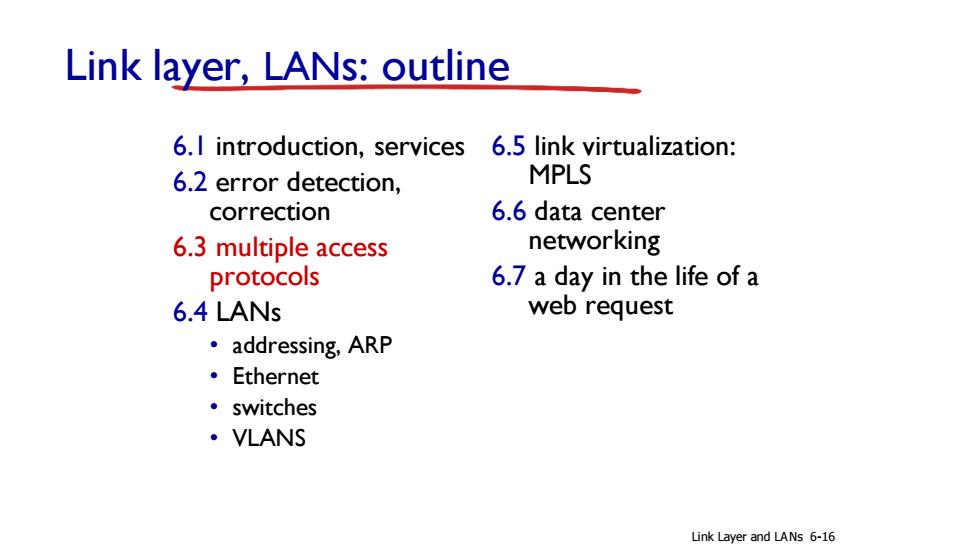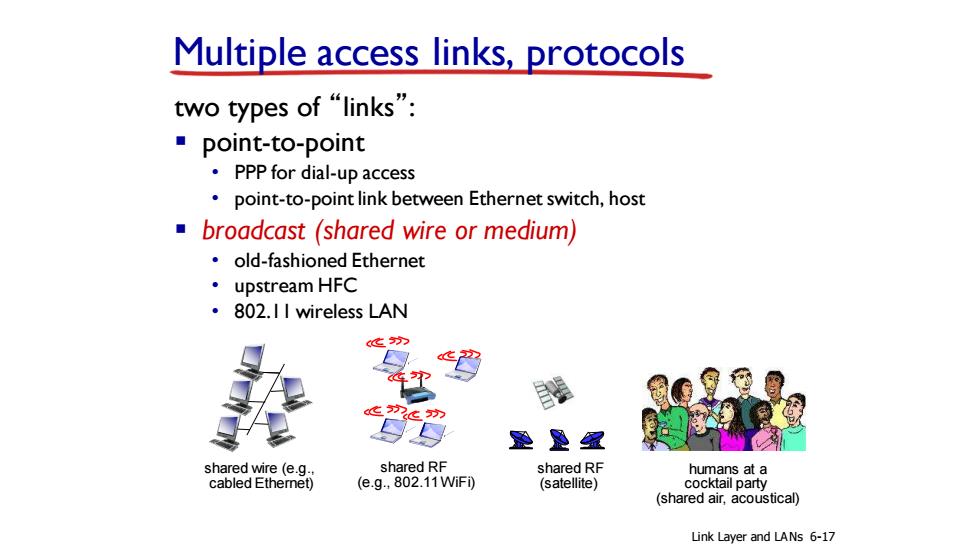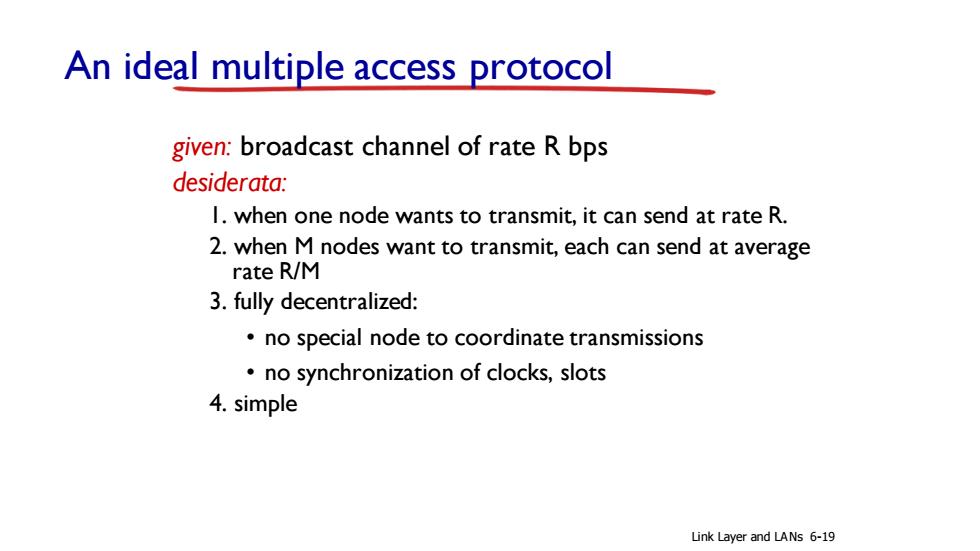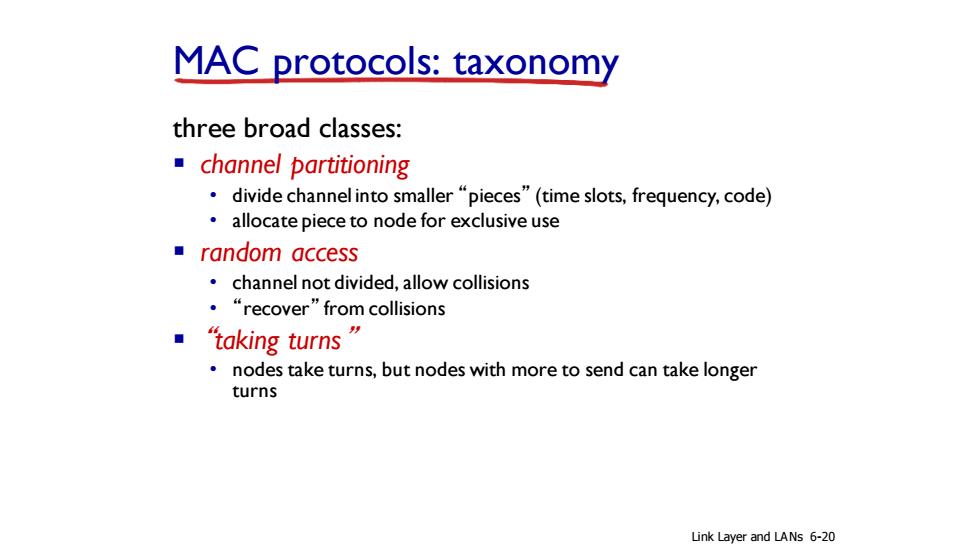
Link layer,LANs:outline 6.I introduction,services 6.5 link virtualization: 6.2 error detection, MPLS correction 6.6 data center 6.3 multiple access networking protocols 6.7 a day in the life of a 6.4 LANs web request ·addressing,ARP ·Ethernet ·switches ·VLANS Link Layer and LANs 6-16
Link layer, LANs: outline 6.1 introduction, services 6.2 error detection, correction 6.3 multiple access protocols 6.4 LANs • addressing, ARP • Ethernet • switches • VLANS 6.5 link virtualization: MPLS 6.6 data center networking 6.7 a day in the life of a web request Link Layer and LANs 6-16

Multiple access links,protocols two types of“links'”: ■point-to-point PPP for dial-up access point-to-point link between Ethernet switch,host broadcast(shared wire or medium) old-fashioned Ethernet ·upstream HFC ·802.II wireless LAN E 是是显 shared wire (e.g.. shared RF shared RF humans at a cabled Etheret) (e.g,802.11Wif) (satellite) cocktail party (shared air,acoustical) Link Layer and LANs 6-17
Multiple access links, protocols two types of “links” : ▪ point-to-point • PPP for dial-up access • point-to-point link between Ethernet switch, host ▪ broadcast (shared wire or medium) • old-fashioned Ethernet • upstream HFC • 802.11 wireless LAN shared wire (e.g., cabled Ethernet) shared RF (e.g., 802.11 WiFi) shared RF (satellite) humans at a cocktail party (shared air, acoustical) Link Layer and LANs 6-17

Multiple access protocols single shared broadcast channel two or more simultaneous transmissions by nodes: interference collision if node receives two or more signals at the same time multiple access protocol distributed algorithm that determines how nodes share channel,i.e.,determine when node can transmit communication about channel sharing must use channel itself! no out-of-band channel for coordination Link Layer and LANs 6-18
Multiple access protocols ▪ single shared broadcast channel ▪ two or more simultaneous transmissions by nodes: interference • collision if node receives two or more signals at the same time multiple access protocol ▪ distributed algorithm that determines how nodes share channel, i.e., determine when node can transmit ▪ communication about channel sharing must use channel itself! • no out-of-band channel for coordination Link Layer and LANs 6-18

An ideal multiple access protocol given:broadcast channel of rate R bps desiderata: 1.when one node wants to transmit,it can send at rate R. 2.when M nodes want to transmit,each can send at average rate R/M 3.fully decentralized: no special node to coordinate transmissions no synchronization of clocks,slots 4.simple Link Layer and LANs 6-19
An ideal multiple access protocol given: broadcast channel of rate R bps desiderata: 1. when one node wants to transmit, it can send at rate R. 2. when M nodes want to transmit, each can send at average rate R/M 3. fully decentralized: • no special node to coordinate transmissions • no synchronization of clocks, slots 4. simple Link Layer and LANs 6-19

MAC protocols:taxonomy three broad classes: channel partitioning ·divide channel into smaller“pieces”(time slots,frequency,,code) allocate piece to node for exclusive use ■random access channel not divided,allow collisions ."recover"from collisions taking turns nodes take turns,but nodes with more to send can take longer turns Link Layer and LANs 6-20
MAC protocols: taxonomy three broad classes: ▪ channel partitioning • divide channel into smaller “pieces” (time slots, frequency, code) • allocate piece to node for exclusive use ▪ random access • channel not divided, allow collisions • “ recover ” from collisions ▪ “taking turns” • nodes take turns, but nodes with more to send can take longer turns Link Layer and LANs 6-20